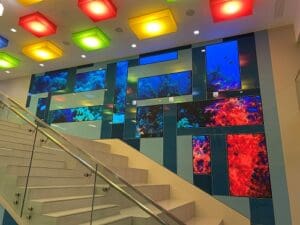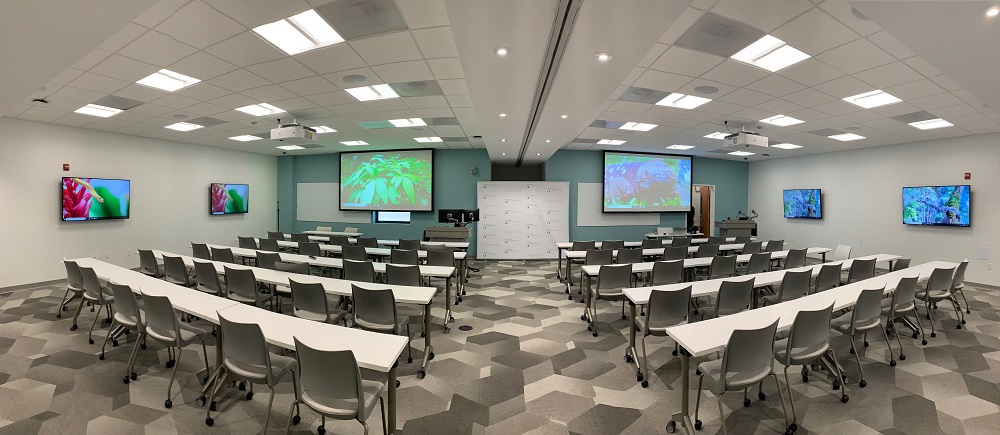Videoconferencing usage has accelerated in today’s learning environments, and it shows no sign of stopping. J.C. Laucirica, president of integrator Innovate-AV agrees that there’s no going back to the way things were pre-COVID-19. The change is permanent.
Higher-education clients are looking for more digital-forward classrooms that incorporate immersive solutions that work seamlessly with all video-collaboration applications to provide an experience that both in-person students and remote students can see, hear and participate in. “There’s a new expectation that everybody is on video participating,” Dana Corey, senior vice president and general manager of global sales at Avocor, says. “At least those who are delivering the message must be on video.”
Download: 2022 Hybrid Learning Deep Dive
“[With] collaboration and visualization, we retain more…we experience more,” Corey continues. “We are more engaged in those types of environments.” Now that integrators must outfit rooms for hybrid learning, there’s a pressing need to deliver an experience that is visual, larger and interactive. Those elements, Corey adds, are foundational to retention.
Understanding Clients’ Needs
The first — and often most important — step in a higher-ed project is understanding the client’s needs. Corey relates a series of questions, saying, “What’s the need for those [who are] remote? What’s the need for those in the room? What are their objectives?” Integrators must consider what educators and students, respectively, seek — that is, what “value” looks like to them. Only then, Corey says, can integrators deliver on that.
One of the greatest challenges in delivering technology-driven outcomes is that every room is not created equal. Each room represents a unique environment with its own size, spacing of people, and component materials. A room could have glass walls versus hard walls — or it could have no walls at all. A room could have poor lighting conditions or good lighting conditions. It might also present the spatial problems that integrators must consider in their designs. Thus, integrators would be well served to look for tools that are like Swiss Army knives, flexible in their deployment options.
These days, integrators must have a strong understanding of both the hardware and the software that make education spaces function. And then, on top of that, they must boast a strong knowledge of cloud-based architecture.
On the hardware side, PTZ cameras with tracking technologies to follow a speaker around have become popular, as have ceiling and beamforming microphones. And, according to Innovate-AV’s Laucirica, there’s room the digital signage solutions category is ripe for exponential growth.
Digital Signage Opportunities
Jason Young, national sales manager for B2B sales at Sony, attests to notable growth in the company’s digital signage displays and display-management software. He also notes that he’s seeing a larger number of higher-education clients asking for a more centralized digital signage infrastructure.
Young recalls a client who came to him and indicated that he was aware of eight or nine different digital signage solutions across his campus, but he couldn’t pinpoint the varying specifics of each. “It’s usually hit or miss,” Young says, indicating that some departments execute these implementations better than others do. “And, a lot of times, it’s so decentralized that you’ve got different groups doing their own thing,” he adds.
 Avocor’s Corey says, whatever solutions integrators decide to implement, they must keep agility at the forefront of their minds. “Don’t develop a solution that has no ability to adapt,” he warns. “Don’t put in hardware that can’t be moldable to something else. Don’t put any architecture together, ideally, that can’t be amenable to other platforms or more needs.” Continuing, he says, “Be ready for change. And make sure that you think through that on all things — specifically, the hardware and software.”
Avocor’s Corey says, whatever solutions integrators decide to implement, they must keep agility at the forefront of their minds. “Don’t develop a solution that has no ability to adapt,” he warns. “Don’t put in hardware that can’t be moldable to something else. Don’t put any architecture together, ideally, that can’t be amenable to other platforms or more needs.” Continuing, he says, “Be ready for change. And make sure that you think through that on all things — specifically, the hardware and software.”
Corey adds that integrators should utilize knowledge from one higher-education campus to open the door to help others. “They could bring [those solutions] forward to other campuses,” he explains, “because the challenges are similar — almost nearly identical at times.”
Corey continues, “Administrators talk to each other. They want to tout how good they are and show the world, because that’s how they [attract] students and teachers to come onboard.” Thus, he concludes, “If you get one or two [higher-education clients] and can get them to talk about it, which they will want to, then other schools will come along. All that work could be worth a lot more than just the one or two campuses you’re working on.”










